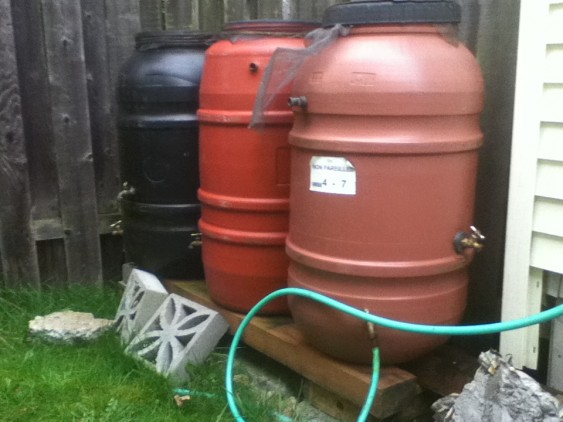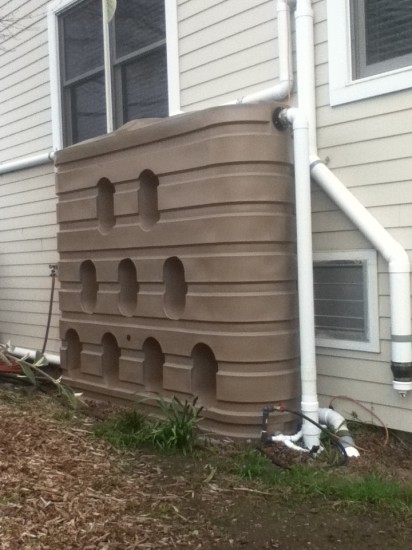Call me a dreamer. I want to flush with rainwater. Rain barrels already anchor my downspouts. I want to hitch them to my toilet tank. It would save me money and leave the city’s drinking water for better uses.
Yet so far local plumbing rules aren’t helping me, or thousands of others in the Pacific “Northwet,” make the rain-barrel connection. It’s not so much that rules prohibit it but that even local authorities do not really understand what the rules mean. A little clarification—and publicity—would go a long way.
Already, outside my house in Seattle’s Ballard neighborhood, I’ve managed to irrigate my Victory Garden all summer from nothing but the 500 gallons of rain I collect in ten barrels. During the other three seasons, though, the garden doesn’t need extra moisture, so my barrels sit unused and, often, full to the brim.

So I’m flushing my toilet with pure, treated drinking water that’s piped scores of miles from the Cascades while I’ve got hundreds of gallons of free, naturally delivered, and naturally replenished rain stockpiled just outside my bathroom wall. Perhaps you now understand the intensity of my dream? A Rain Water Toilet Flush System (RWTF)!
I’m a perfect candidate: I live in a 1920 single-floor, 800-square-foot fisherman’s shack, so everything is down low to the ground and close together. My girlfriend and I have been doing our best to conserve water. Our consumption this past winter, for example, was half of what we used a year earlier. According to Seattle Public Utilities, we got our average daily water consumption down to 25 gallons apiece. The US average is 70 gallons per person per day according to the US Environmental Protection Agency. Vancouver, BC, estimates its citizens use an average of 90 gallons (340 liters) per day, a figure that can double in the summer with outdoor irrigation. By connecting our rain barrels to the toilets, we could reduce our water use by another 9 gallons a day (6 flushes a day x 1.6 gallons per flush). Also, we could stop being one of those stinky “if it’s yellow, let it mellow” households!
On a policy level, a toilet can account for anywhere from 27 percent (older toilets) to 8 percent (low-flow) of household water use. There are over 130,000 single-family homes in the city of Seattle; an average household size is 2.84, so 369,000 Seattleites live in such abodes. If only 10 percent of these homes used such a set-up to reduce their municipal water use by a quarter, it would save more than 645,000 gallons of water a day, or 19 million gallons a month. Extend that math across Cascadia, and the savings multiply.
On a personal level, I have a single toilet situated just a few feet above ground level. Connecting it to my rain barrels should be easy, right?
Wrong.
THE PROBLEM
Unfortunately, it’s not as simple as drilling a hole through the wall and attaching the toilet to the barrel (aka “Experiment #1”, don’t tell the plumbing inspector, but I may have already tried that). It involves principles of hydro- and seismic engineering. For a gravity-fed system, you need height. Water weighs 8.3 pounds a gallon. A full 50 gallon barrel weighs more than 400 pounds. Hoisting it to an adequate height, in earthquake country, you need some reinforced structure. Not too complicated, but definitely not simple.
And then there’s the permitting.
Both Washington State and Seattle allow rainwater catchment systems for indoor, non-potable use, but finding out how it’s done and what the permits are sure ain’t easy. Trying to do so led me on a three-year wild goose chase that finally, I hope, is coming to a fruitful conclusion.
I found classes and examples of systems, but nearly without exception they were large buildings and off-grid suburban mega-mansions. The main take-away seemed to be that these systems can be done, but to make it worthwhile, they have to be so large (tens of thousands of gallons) and expensive (over $10,000, with a payback timeline of decades), that it makes one ask, “why bother?”
So I looked to Portland, where examples of RWTF systems are almost as common as microbrews and bicycles.
A Google search of “Portland Rainwater Toilet” led me to the Portland Bureau of Planning and Sustainability, which includes some interesting and practical examples of single family RWTF systems. A call to the office put me in touch with Valerie Garrett, who staffs the Green Hotline. After I told her of my quest, she referred me to McKenzie James, Portland’s Senior Plumbing Inspector, and Pat Lando, a local contractor. James detailed the permitting costs: $35 per fixture plus a 12 percent surcharge. When I asked if he knew people who do this, he responded with a sort of “duh.”
Pat Lando clarified everything: he’s been designing and installing rainwater systems for 10 years. He too was stymied by the high costs of household rainwater systems, so he developed his own kit. He hesitated to give estimates, but when pressed, he suggested $2,600 for an installed, effective system. The main costs are the cisterns and installation, so if you’re handy it could be much cheaper.
Not only that, to maximize savings and return in investment, I learned that I could go beyond a RWTF system, to a “Rainwater for Non-potable Household Use (RNHU)” system. That little three-letter switch in acronyms would allow me to use rainwater not only for the largest consumer of indoor water (the john) but also for the second largest: the washing machine! Doing so would cut household water use not by 27 percent, but by half!
My experience talking to Portlanders made me think the wall I’d been slamming into in Washington was about the codes. Does Oregon use a different plumbing code that allows the installation of RNHU systems, while Washington follows another that does not? No. Both states use the International Built Plumbing Code.
Knowing what to look for now, thanks to Oregon’s guidance, I searched on and, sure enough, finally found someone who installs affordable RNHU systems in Washington. Michael Durland of PurRain has been designing and installing them for more than 25 years in northwest Washington. Much of his business is in the San Juan Islands, where rain is abundant but ground water is not. ”[Rain-water plumbing] does not need to be complicated but some contractors I know make it so,” he told me.
Durland defines “affordable”: the main costs are rainwater storage tanks, which run $1,200 to $1,400; the pump, costing $300 to $800; and various other parts, which add less than $200. He has installed systems in Jefferson and Whatcom Counties. He also designed a system for installation in King County but local plumbing inspectors “said I had to pass the rainwater collection course put out by ARCSA [American Rainwater Catchment Systems Association],” said Durland. “I was putting systems together before they started and am hesitant to pay money to be ‘approved’ to do it.”
Durland also pinpointed a practical, rather than legal, difference between Oregon and Washington’s plumbing rules: the Oregon health department publishes detailed instructions on how to do—and how to inspect—RNHU systems. The Washington State Health Department does not. There is no detailed statewide reference document on how to use rain water safely indoors, so counties have to make up their own. Guess what? Most haven’t.
Larry Fay of King County Department of Public Health explained that Washington is behind Oregon partly because of timing: only in 2009 did the Washington Department of Ecology allow rainwater catchment systems at all; before that, capturing and storing rainwater violated water resource law (a common occurrence in Western states). So far, only Jefferson, King, San Juan, and Whatcom Counties have begun approving systems.

Finally, for $210, King County residents like me can get a permit for a standard plumbing fixture and three outlets to use rain water. (I would only use two outlets: toilet and washing machine.) The price includes review. Once my plan passes review, I can legally start tapping my rain barrels for indoor use. Or I can get a bigger storage unit, a cistern (currently eligible for a rebate for Seattle residents from the Rainwise program, which is currently expanding from Ballard to other neighborhoods) for indoor use. Plumbing authorities’ main concern is that your rainwater system doesn’t cross-connect with the municipal lines, allowing contamination of city drinking water.
(What’s more, King County’s new approach will even allow rainwater catchment systems to provide household potable water. That’s right. You’ll be able to put the stuff in your dishwasher or sink. You’ll just need to pay for a review of your plumber’s plans, at an hourly rate of $201. (Standard houses, I’ve been told, will rarely take more than an hour.)
No word if Idaho or BC has adopted these policies. (If you know, drop us a line!) Nor if Washington will make life easier for its county health departments by adopting a state-wide policy like in Oregon. But in King County, at least, the “someday” when we’ll make the rain-barrel connection is drawing closer all the time, for the regulations, the dreamers, and me.
Chris LaRoche focused his MPA studies on developing innovative, community solutions to grand, global challenges like climate change and water resource management. A rainwater capture system is an integral part of his zombie apocalypse plan.


Comments are closed.